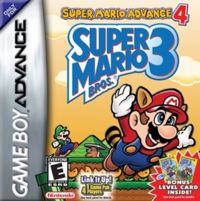Difference between revisions of "Super Mario Advance 4: Super Mario Bros. 3"
(New page: {{Game |name=Super Mario Advance 4 |image=200px |bgcolor=silver |fgcolor=black |developer=Nintendo R&D 2 |publisher=Nintendo |system=[[Gameboy Advanc...) |
WarioFan63 (talk | contribs) |
||
| Line 6: | Line 6: | ||
|developer=[[R&D 2|Nintendo R&D 2]] | |developer=[[R&D 2|Nintendo R&D 2]] | ||
|publisher=[[Nintendo]] | |publisher=[[Nintendo]] | ||
| − | |system=[[ | + | |system=[[Game Boy Advance]] |
|release=JP July 11, 2003<br>US October 17, 2003<br>EU October 21, 2003 | |release=JP July 11, 2003<br>US October 17, 2003<br>EU October 21, 2003 | ||
|gallery=[http://www.gamehiker.com/gallery/index.php?cat=65 GH Gallery] | |gallery=[http://www.gamehiker.com/gallery/index.php?cat=65 GH Gallery] | ||
| Line 30: | Line 30: | ||
*Although it is considered the last of the ''Super Mario Advance'' series, ''[[Super Mario 64 DS]]'' could be considered the [[Nintendo DS]] counterpart to the ''Super Mario Advance'' games. | *Although it is considered the last of the ''Super Mario Advance'' series, ''[[Super Mario 64 DS]]'' could be considered the [[Nintendo DS]] counterpart to the ''Super Mario Advance'' games. | ||
| − | [[Category: | + | [[Category: Game Boy Advance Games]][[Category: Mario Games]] |
Revision as of 22:12, 6 January 2010

| |
| Super Mario Advance 4 | |
| Developer | Nintendo R&D 2 |
| Publisher | Nintendo |
| System | Game Boy Advance |
| Release Date | JP July 11, 2003 US October 17, 2003 EU October 21, 2003 |
| Gallery | GH Gallery |
| Rating | ESRB: E |
Super Mario Advance 4: Super Mario Bros. 3 is the final installment of the Super Mario Advance series of remakes of classic Mario games for the Gameboy Advance. As its name suggests, it acts as a port of Super Mario Bros. 3.
Information
Super Mario Advance 4 had few changes to the main Super Mario Bros. 3 games such as adding voice acting for the Mario Bros., a saving feature and graphical updates.
The main addition to the game came with e-Reader compatibility. There were three types of cards that could be scanned to receive power-ups, unlock new levels in the e-World or view gameplay movies of special tricks. The power-ups included ones from other games such as the Cape Feather from Super Mario World and vegetables from Super Mario Bros. 2. The e-World also contained whole new levels.
However, due to the unpopularity of the e-Reader in America and its discontinuation not long afterwards, only about one-third of the total amount of cards in Japan were released in America. Additionally, Europe did not have the feature at all due to the e-Reader never having been released there to begin with.
Like the previous Super Mario Advance games, it contained the improved Mario Bros. Classic minigame with both single player and multi-player modes.
Legacy
Sequels
- Although it is considered the last of the Super Mario Advance series, Super Mario 64 DS could be considered the Nintendo DS counterpart to the Super Mario Advance games.